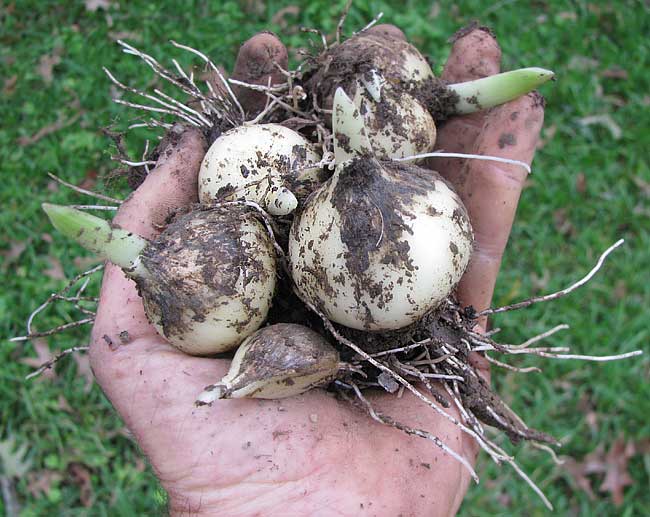Excerpts from Jim Conrad's
Naturalist Newsletter

from the the October 18, 2009 Newsletter, from near Natchez, Mississippi
DIGGING ELEPHANT GARLIC BULBS
When I left the plantation near here where I spent my hermit years I dug up lots of Elephant Garlic, which I planted here at Karen's place. Each year since, the plants have returned with exuberance, have proliferated, and each time I drift through here they make my morning-campfire stews so good. When the taste of that steaming, super-garlicky stew mingles with the odor of woodsmoke, I feel more "at home" than any other time.
One of the first things I did when I got here last week was to go dig some garlic bulbs, as shown above.
When I was here early last spring the plants were about knee-high. Back then the bulbs had basically disintegrated around the base of the nearly inch-thick stems, the stems were succulent and every bit as garlicky as the bulbs were, so I tore off the tough leaves and the brown bulb-remnants, and sliced and diced the stem into my stews.
At that time, softball-size heads of closely clustered onion flowers stood atop the plants, then during summer's hot, dry days the plants died back and were mowed over so it was hard to tell they'd ever been there. Right now the only indication of their presence is that here and there a few short, green shoots arise from the mud.
Elephant garlic isn't "real" garlic. It's a leek, which explains why last spring the plant's stem was so thick and pulpy. "Real garlics" are known by the technical name of Allium sativum. Elephant Garlic belongs to the same genus but it's a different species: It's ALLIUM AMPELOPRASUM.
When a "real garlic's" bulb matures, it separates into several cloves and each clove is contained within its own white, papery wrapper. Elephant Garlic does produce cloves, but they're fewer in number, much larger, and though the cloves also are encased in their own wrappers, the wrappers aren't nearly as white, papery and flaky as a "real garlic's" cloves. Elephant Garlics usually produce five or so cloves that are a bit yellowish compared to a "real garlic's" milk-white cloves. I read that Elephant Garlic has a somewhat milder taste than "real garlic," and that the taste has onion-like edge to it. I don't really see any difference between them.